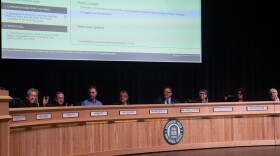The Henry Ford Museum in Dearborn, Mich., is to automobiles what the National Gallery is to art.
The museum has just opened a new exhibit called "Driving America" that looks at the automobile from the point of view of the driver. Curators say they hope the new exhibit will encourage visitors to consider — and maybe reconsider — their own cars and driving habits.
At the museum, there's everything from a yellow Corvette to a red Model T. As you look through the cars, you can see the history and the promise of the American auto industry.
Bob Casey, the museum's senior curator of transportation, is our tour guide through an exhibit that charts how cars evolved from an overgrown toy to the piece of machinery that most defines American life.
"The car that marks the big demarcation point is this red Ford," says Casey, pointing to a 1909 Model T.
Contrary to popular belief, they weren't only made in black.
"Only 11 1/2 million were," he says. "And this is what changed automobiles from being pleasure vehicles to being passenger vehicles. It is easily the most significant car of the 20th century, and I haven't seen any vehicle yet that has been as transformative as the Model T was."
Next up: a 1966 Toyota Corona — short, boxy and blue — which Casey says marked another significant milestone.
"This car and a very similar car from Nissan, called a Datsun 510 — these two cars are what really gave the Japanese a foothold in the American market," he says.
There are dozens of cars here: The first Volkswagen Beetle from 1949, a '70s Chrysler Newport sedan that's longer than a modern Chevy Suburban.
Finally, we come to the early 2000s, and a Toyota Prius and Dodge Ram truck.
"On purpose, they represent two extremes of what people want out of a vehicle," Casey says. "And in essence ... to each visitor, we're saying, 'What do you think a car should be? Which direction should we be going in the future?' "
Casey, who walks to work at the car museum every day, says eventually our relationship with the automobile will have to change. But this time, instead of changing by accident, we're going to have to think about it first.
Copyright 2022 NPR. To see more, visit https://www.npr.org. 9(MDAzMjM2NDYzMDEyMzc1Njk5NjAxNzY3OQ001))






